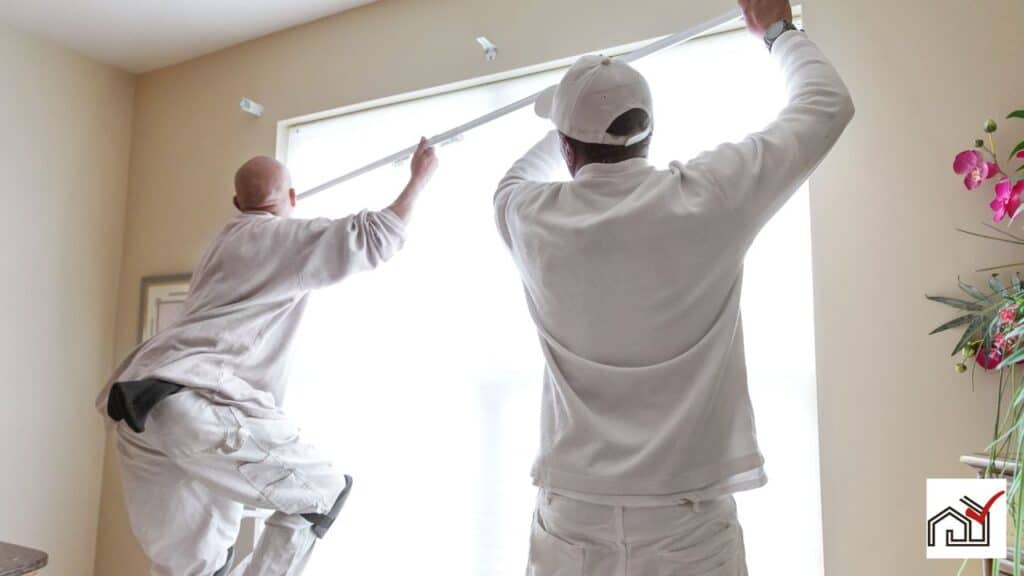Curtain rod brackets should be installed several inches above and outside the window frame. This not only makes the window appear larger, but also allows the curtains to be fully opened, letting in more light.
To ensure proper installation, it is important to make sure the brackets are level and securely attached to wall studs. If wall studs are not available, wall anchors can be used for support.
For special window types, adjustments may be needed to keep the curtains even and functional. Taking the time to properly install the brackets is important for both the aesthetic look and the functional use of the curtains.
Assessing Window Dimensions
Measuring the width of a window frame is the first step in choosing the correct location for curtain rod brackets. Face the window and use a tape measure to measure from one side of the frame to the other, keeping the tape level for an accurate measurement. This step is essential for proper window treatment installation.
After determining the width, add 8 to 12 inches to the rod length to allow curtains to hang without blocking light when opened and to create a visually pleasing overhang. Positioning the brackets several inches above the window can make the space and ceiling appear taller. Typically, the rod is placed up to 6 inches above the frame, but this can vary based on ceiling height and preference.
When considering curtain width, account for the fullness required for gathers or pleats, which may mean the fabric width should be two to three times that of the window frame. The correct rod size must reflect both the window frame width and the curtain fullness.
Brackets should be placed according to the determined rod length, ensuring even support for the weight and width of the curtains. Proper initial measurements will lead to a smooth and effective window treatment installation.
Determining Bracket Height
To install curtain rod brackets, follow these steps:
- Measure from the top of the window frame to the ceiling.
- Measure the window’s width.
- Plan to place the brackets four to six inches beyond the window’s width on each side. This helps the curtains frame the window when open.
Mark the bracket locations with a pencil, ensuring the marks are level to keep the curtains even.
For wide windows, add a center bracket to prevent the rod from sagging.
Hang the rod four to six inches above the window frame to enhance the room’s height.
Use a level to align the marks for the brackets on both sides.
If using an adjustable rod, ensure it extends equally on both sides.
After marking the positions, install the hardware and hang the curtains.
Calculating Bracket Width
To install curtain rod brackets correctly, follow these steps:
- Measure the window width and add 8 to 12 inches. This extension helps the curtains frame the window and prevents light blockage when open.
- Choose a curtain rod that matches the window and decor.
- Mark the wall for bracket placement using a level for straight lines. The distance from the window molding to the mark should equal the window width plus the extension.
- Determine the spacing for the brackets by dividing the rod’s total length by the number of brackets needed. Typically, two brackets are used, but wider windows may require a third for support.
- Install the brackets securely to avoid sagging and ensure proper curtain function.
Aligning With Wall Studs
For proper support, it’s important to align curtain rod brackets with wall studs before marking their position. This provides a stable base for the weight of the curtains. Use a stud finder to locate the studs and then mark where the brackets will go.
Next, position the brackets on the marks and use a level to ensure they’re straight. Drill pilot holes at the marked spots to help guide the screws into the studs.
If wall studs are not in the correct places for the curtain rod, use wall anchors for support. Choose anchors that can handle the curtain weight.
Finalizing Bracket Position
Before securing curtain rod brackets, it is crucial to confirm their placement for both function and aesthetics. Mark the wall where the brackets will go, ensuring careful preparation for successful installation.
Re-measure the distance from the window frame to each mark to check for symmetry. Use a level to confirm that the brackets will be horizontal. This is important to avoid uneven curtains, which can negatively affect the room’s look.
After verifying the marks, install the curtain rod brackets. If there’s no stud, use wall anchors for a secure attachment. Drill holes at the marked spots and screw the brackets in place.
Thread the curtains onto the rod before hanging to make sure they move smoothly and make any adjustments to their length or pleats. Then, place the rod into the brackets and secure it, using set screws if provided.
Accurate measuring, marking, and leveling are key to ensuring the curtains function properly and look good in the room.
Tips for Specialty Windows
For specialty windows, a custom approach is necessary to ensure proper fit and function. Measure the window accurately, especially if it’s an unusual size like French doors or shallow windows. The window’s recess depth affects the choice of curtain rod brackets, which should not hinder the window’s operation. For shallow windows, consider adhesive hooks to avoid bulky brackets.
Choose U-shaped curtain rods for windows with limited side space, making sure the rod extends beyond the window depth for proper curtain hang. Select a decorative finial that matches the decor but doesn’t impede window functionality.
For layered or heavy curtains on specialty windows, use sturdy brackets capable of supporting the weight without damaging the frame. Kwik-Hang brackets are a drill-free option that protects the wall or frame while securely holding various rod styles and curtain weights.




